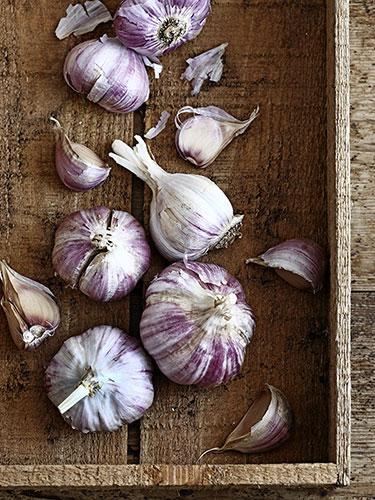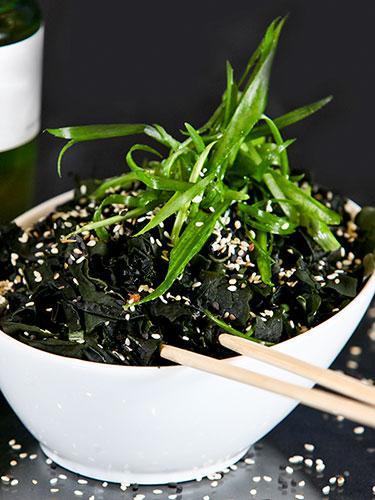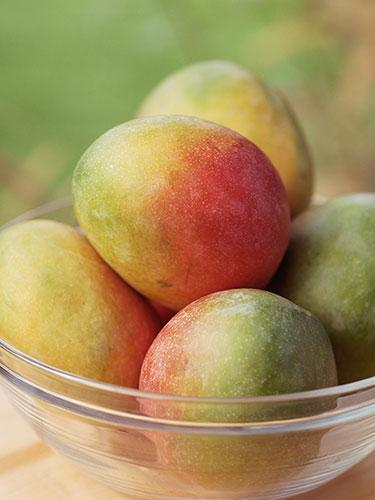10 Foods to Eat So You Never Have to Diet

Photo by Getty Images
By Amy Capetta
These powerhouse foods help keep unwanted pounds at bay, and it has nothing to do with counting calories and fat grams.
Garlic
This herb does more than just
give meals extra flavor and scent—it can also help keep your tummy flat
through its naturally occurring chemical allicin, says registered
dietitian andNutritious Life founder
Keri Glassman. “Allicin kills off harmful bacteria in your digestive
tract to keep your gut healthy and functioning, which means less bloat.”
Also, Korean researchers discovered that
this member of the onion family may have an anti-obesity effect thanks
to proteins being stimulated in the liver. Toss garlic in almost any
poultry, pasta, or veggie dish, or add it to dressings and sauces.
Beans
When you’re craving carbs, look no further than the legume family, says registered dietitian and food and nutrition consultant Rachel Begun.
“Beans are unique in that they offer significant amounts of both fiber
and protein in one package—one cup of black beans has a whopping 17
grams of fiber and 14 grams of protein. We’re learning that fiber and
protein are invaluable for weight management because both are highly
satiating, meaning they leave us feeling full for longer and prevent
overeating later in the day.” A recent studypublished
in the journal Obesity found that extracts from white kidney beans can
reduce the absorption of calories from carbohydrates and tame sweets
cravings, thanks to certain enzymes that inhibit starch digestion.
Pistachios
“In-shell pistachios are one of
my go-to snacks for weight management,” says Katherine Brooking, a
registered dietitian and cofounder of Appetite for Health.
A one-ounce serving has 6 grams of protein and 3 grams of fiber, but
their real power is felt more in your eyes than your stomach. “Needing
to de-shell helps you munch more slowly, and the discarded shells may
also provide a visual cue to remind you of how much you’ve eaten, which
helps put the brakes on out-of-control snacking,” adds Brooking. In
fact, in a study conducted
at Eastern Illinois University, participants who snacked on in-shell
pistachios consumed 41 percent fewer calories compared to those who ate
the shelled version.

(Photo Credit: Getty Images)
Seaweed
Perhaps we should take tips from
the Japanese, whose country has one of the lowest obesity rates in the
world, says registered dietitian and Appetite for Health cofounder
Julie Upton. One of their staples is wakame, a type of nutrient- and
protein-rich seaweed. “Compounds isolated from wakame, [known as]
fucoxanthin, have been shown to
help increase fat burning in animal model studies,” says Upton. “More
studies are currently looking at other compounds in seaweed, like
alginates, that form gels in the stomach to enhance feelings of
fullness.” Toss seaweed into soups and salads or use it instead of
lettuce in wraps and sandwiches.
Jalapeños
Good news for those who like it
hot. “Jalapeño peppers contain an antioxidant called capsaicin, which
acts as a powerful anti-inflammatory and metabolism booster,” says
Glassman. “Some studies have found that people who eat pepper-packed
meals feel less hungry and burn more calories later.” One such study
conducted at Purdue University discovered that volunteers who
infrequently consumed this spicy, nutrient-dense vegetable reaped more
of its weight-loss benefits, a result of experiencing less hunger,
especially for fatty, salty, and sweet foods. According to researchers,
sprinkling red pepper on a meal “may be sustainable and beneficial in
the long run, especially when paired with exercise and healthy eating.”
RELATED: How To Beat Bloat In 24 Hours
White potatoes
Who said all white foods are
off-limits? “White potatoes are actually a slimming food,” says
Glassman. The reason: They’re full of rich resistant starch, a compound
that ferments in the gut and creates butyrate, a fatty acid that may
spur your body to burn more fat. A studypublished
in the journal Diabetes found that butyrate also improved insulin
sensitivity and increased energy expenditure in mice.

(Photo Credit: Getty Images)
Mangos
While these juicy stone fruits
are naturally filling due to their fiber content—a medium one contains 3
grams—that’s not the only reason they help peel off the pounds. “New researchfrom
Oklahoma State University indicates that mangoes may lower blood sugar,
which can help to control cravings, especially for carbs, thus keeping
your willpower intact,” says Brooking. And good news: Since mangoes are
grown in tropical climates all over the world, they’re available
year-round.
RELATED: 25 Lazy Ways To Stay Skinny
Yogurt
It’s more than just a low-cal
standby. “The calcium in yogurt may help lower calcitrol in the body,
which helps turn on fat burning and turn down fat storage,” says
Brooking. “Plus, the beneficial probiotics in yogurt feed your gut, and
we now know that gut microbes in those who are a healthy weight are
different than in those who are obese.” The way yogurt is made, which
includes fermentation, also gives it higher concentrations of protein,
B-vitamins, calcium, potassium, and magnesium compared to milk, making
it the ultimate dairy food.
Avocado
More than 80 percent of the calories in avocados are from fat—but they’re still incredibly good for you, says Upton. “Research shows
that people who eat avocados have lower BMIs, and a recent study of
overweight men and women found that adding avocados to lunch increased
satisfaction by 22 percent. It also reduced desire to eat over the next
three hours by 24 percent.” The study authors suggest that the fiber,
unsaturated fat content, and a blood-sugar-lowering sugar called
D-mannoheptulose may play a role in helping steady blood sugar levels
and keeping appetite in check.

(Photo Credit: Getty Images)
Artichokes
These veggies are rich in fiber,
with each medium-size one packing 6 grams. “Fiber is valuable if you’re
trying to lose weight because it actually slows digestion so that you
feel full longer,” says Glassman. “It also means more volume for fewer
calories.” And artichokes promote good gut health. They contain
indigestible nutrients, called prebiotics, that help support the good
bacteria in your digestive system, which can deflate belly bloat and
flatten your tummy.
Original post found here:





Post a Comment